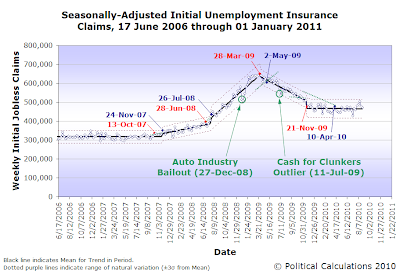Seasonally-adjusted first time jobless claims were announced on 2 September 2010 to be 472,000. Which was down some 6,000 from the previous week's revised total of new initial unemployment insurance claims of 478,000, which itself was down from the 504,000 filings of two weeks ago.
You might think those numbers represent a positive trend, as it would seem that the number of people filing unemployment insurance claims for the first time after having been laid off from their jobs seems to be falling. You would be wrong.

The problem is that the number of new unemployment claims is becoming flat at a level far higher than the average 318,000 level that was typical during the full-employment, low-unemployment years of 2006 and 2007. Instead, we find the level of new jobless claims would appear to be stabilizing around a level of 465,000 weekly claims, some 147,000 claims higher than would be consistent with a growing U.S. economy.
Using the standard deviation of the data for initial unemployment insurance claims filed since 21 November 2009, and assuming a normal bell-curve type distribution, we can now reasonably expect new weekly jobless claims filings will range between 415,000 and 515,000. A data figure falling outside of this range would be unexpected.
We would estimate a 68% probability that any future weekly jobless claims figure will fall between 448,000 and 482,000.
At least, until something happens to break the current trend, must as the introduction of health care reform legislation did to change the trend for the employee retention decisions of U.S. businesses back in November 2009. Prior to the introduction of the HR 3962 bill, the situation for new jobless claims was actually improving at a rapid rate, but the strong likelihood that health care reform that would impose higher costs on businesses would pass into law derailed it.
We had thought as recently as two weeks ago that a new negative trend might be in the process of being established, however the data of the last two weeks suggests that the current trend remains in effect, as the rules we follow for determining when an existing trend is broken weren't tripped.
Labels: jobs
Welcome to the blogosphere's toolchest! Here, unlike other blogs dedicated to analyzing current events, we create easy-to-use, simple tools to do the math related to them so you can get in on the action too! If you would like to learn more about these tools, or if you would like to contribute ideas to develop for this blog, please e-mail us at:
ironman at politicalcalculations
Thanks in advance!
Closing values for previous trading day.
This site is primarily powered by:
CSS Validation
RSS Site Feed
JavaScript
The tools on this site are built using JavaScript. If you would like to learn more, one of the best free resources on the web is available at W3Schools.com.